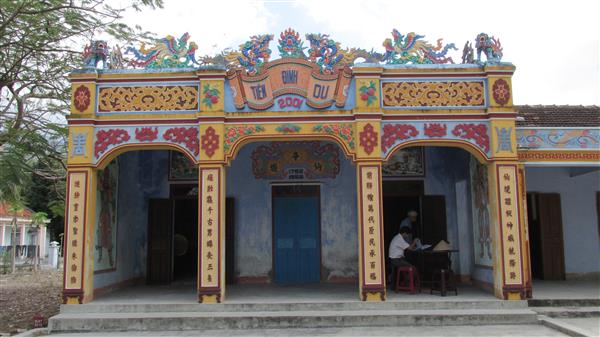Description
Tien Du communal house is located in Tien Du 1 village, Ninh Phu commune, Ninh Hoa town, Khanh Hoa province.
* Origin of relics
The name Tien Du is taken from the village name. In the memory of many people, in the old days, Mr. Tran Quang Nui (Quang Binh) lived in oppression, so he sailed to Hon Thi and stayed with his great-grandfather, Mr. Duong Ganh (Tien Du, Ninh Phu). You joined the Tay Son surface defense team at Ke Ga cape led by Mr. Le Van Quang. In 1776, Mr. Nui sailed back to Quang Binh and brought the whole family to reside at Ben Tau O. By 1780, Mr. Nui had converted, founded a village and lived in Tien Du village for 4 years.
In 1782, when the life of the people of Tien Du village gradually stabilized, Mr. Tran Quang Nui stood up to call on the villagers to contribute effort and money, building materials for Tien Du communal house. According to the elders in the village, Tien Du communal house was bestowed 05 ordinations by the Nguyen kings but was lost during the resistance war against the French colonialists.
Since its inception, Tien Du communal house has undergone many years of renovation: 1947, 1964, 2001, 2004, 2009.
Tien Du communal house was built to worship the following gods: Ban Canh Thanh Hoang, Tien Hien (grandfather Tran Quang Nui), Hau Tho, and Son Lam lords.
* Architecture of Tien Du communal house
Tien Du communal house is located at the end of the village on a large, high and airy plot of land, with the front facing west. From the outside to the inside, the communal house has an overall layout including architectural elements: Nghi Mon, Phong Nha, main hall, Pre-Sen house, Son Lam Temple, Hau Tho Temple.


The highlight in decoration and sculpture on the architecture of Tien Du communal house is the system of four spirits: Long, unicorn, turtle, and phoenix which are shown in many shapes such as "Long hidden Van", "Dual Long Dynasty", "Long". code of auxiliary map”… is decorated on the roof of the communal house to pray for favorable weather and good crops - the main occupation of the villagers of Tien Du. In addition, familiar themes such as "Tung Loc", "Bat Fairy", rattan, stylized flowers ... are also thoroughly exploited by the artists through the reliefs on the architecture of Tien Du communal house.
Every year, on April 8-9 (lunar calendar), Tien Du communal house organizes the worship of Tien Hien's death anniversary and prays for "Quoc Thai people and peace". In addition, the communal house also worships on the occasion of the full moon of the seventh month (the festival of Vu Lan to report filial piety and sacrifice to soldiers), year-end worship, and the Lunar New Year. Periodically, "three years of the end of the year" the communal house holds a great ceremony (with boi singing).
* Historical events taking place at the monument
Dinh Tien Du is a place to mark historical events that have taken place at the relic, specifically as follows:
- In the pre-revolutionary period in August 1945, Tien Du communal house was a meeting place, organized activities of many officials of Tan Dinh district such as: Comrade Long, Luong, secretary Le Danh... In addition, Tien Du communal house is also the place where the local militia and self-defense platoon practiced under the training of Mr. Tran Dong (Captain) and Mr. Vo Trang Xuan (Secretary of the Front).
- During the period of resistance against the French colonialists (1945-1954): Dinh Tien Du was the place of accommodation and meetings of revolutionary cadres, including the 80-84th Union Regiment; is the place to place the ballot box for voters in the village to vote to elect deputies to the first National Assembly of the Democratic Republic of Vietnam in 1946. In order to remove an important revolutionary base, in 1947 the enemy dropped bombs and destroyed the entire communal house.
- During the period of resistance against the American imperialists (1954-1975): Tien Du communal house continued to be the place of residence and secret activities of local revolutionary cadres, so the enemy bombarded and completely damaged the house. family in 1964.
On October 14, 2010, Khanh Hoa Provincial People's Committee issued Decision No. 2635/QD-UBND ranking Dinh Tien Du as a provincial historical - cultural relic.